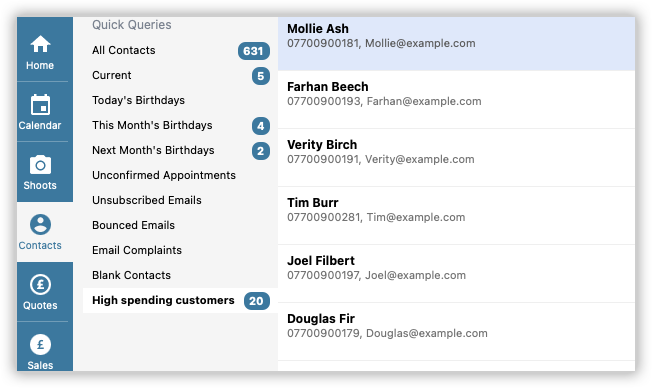Search for answers or browse our knowledge base.
Can't find the answer you need here? Contact our support team and we'll gladly help you.
Using the Query tool and Quick Queries to find information in Light Blue
Using Light Blue means that all the useful information about your business is held in the one place. And as you go about the day-to-day running of your business, all this data is being gathered and linked together helping you to see the bigger picture.
And there are many ways to search for, view and analyse this data within Light Blue; not only are there the inbuilt Charts and Reports, there’s the List View to analyse Records in multiple ways for even deeper insights and you can also run quick searches from the toolbar.
Then last but by no means least there’s the powerful Query tool and Quick Queries to get really specific about the information you want to look at so let’s see what’s possible with these two features.
The Query tool
You can open the Query dialog by clicking the “Query” button in the toolbar, or using the Cmd-F keyboard shortcut on macOS or Ctrl-F on Windows.

Choose which of Light Blue’s main sections you want to search by selecting it from the popup menu at the top of the Query dialog. You can search for Shoots, Contacts, Quotes, Sales, Purchases, or Payments.
A simple Query
Queries can be simple and search for Records that meet just one criteria:

Adding more criteria to your Query
You can fine-tune the results by adding more criteria to your search so that the Records meet all of them; simply imagine saying “and” between each row of the Query.

Advanced options
You can make your Query even more specific by using the Advanced Options available in the Query dialog which allows you to swap “and”‘s for “or”‘s and also group criteria within brackets; think of it as your Query now becoming a more complex formula!
Simply click on the grey brackets to add another bracket and click on the black brackets to remove them. You can even use Custom Fields in your query. 👉 If you’re not familiar with Custom Fields this article explains what they are and how they work.
Here’s a few examples:
Query to find (Contacts who have said they’re not interested OR you’ve decided not to call any more) AND which have outstanding Tasks; ideal for housekeeping after running an outbound lead marketing campaign.

Query to find open Enquiries AND (which are either older than 60 days OR there are no Tasks linked to the Shoot Record); ideal for tidying up particularly old stale enquires and ensuring more recent enquires have some sort of follow-up Task linked to them.

Query to find Sales from a particular financial year AND (where the Shoot status is Enquiry OR Cancelled); handy for seeing any income, such as non-refundable booking fees, from Shoots that didn’t go ahead.

Query to find Confirmed Shoot Records AND which are a Newborn session AND (which have a Newborn Due date 14 days before today OR 14 days after today); great for seeing what babies are due to arrive around about now! NB. The Newborn Due date is a Shoot Custom Field.

Run and refine (“Load Last Query”)
Once you you’ve created your query, click the “Query” button to display the Records that match it. If you need to refine the Query, click on the “Query” button again and then click on the “Load Last Query” button to load it again.
Saving queries (“Quick Queries”)
If you might want to use this Query again in future, you can save it by clicking on the “Save Query” button. This will add it to the “Quick Queries” list for that section. To load Quick Queries, simply go to the relevant section and click on it: Light Blue will show you the matching Records. And if you find that you’ve got too many Quick Queries saved you can right-click on one to either “Hide Query…” or delete it through the “Customise Quick Queries…” option.

Viewing Quick Queries on your Home Screen
You can use Quick Queries on your Home Screen either using the “Quick Query” Widget to show the list of Records or the “Query Totals” Widget to show the total values for the Query.
👉 Find out more here.
Using the List View
Using Light Blue’s List View is a powerful way to delve deeper into the analysis of your Query results. And any information you want to review regularly can be saved as a Custom Report allowing you to easily return to the data at any point in the future.
👉 Explore what’s possible with the List View and Custom Reports in this help article.